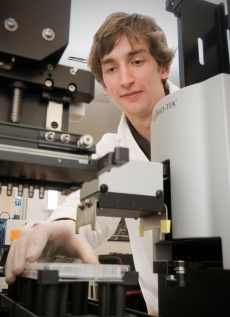Chemical genetics laboratory
Professor Paul Atkinson | Dr Paul Teesdale-Spittle | Dr David Bellows | Dr Andrew Munkacsi

We use Saccharomyces cerevisiae (baker’s yeast) as a model to investigate genetic interactions, screen novel compounds for bioactivity and to understand basic cell processes.
In human therapeutics there are only a limited number of single gene targets, probably because most traits are contributed to by numerous genes. An effective way to treat complex disease is therefore to target multiple genes simultaneously. Since genes act as networks, this approach requires knowledge of the genetic networks involved in pathogenesis.
Combined drugs have worked empirically in cancer therapeutics, but are limited by side effects. A systematic approach based on genetic interaction network analysis would uncover drug combinations that have the fewest side effects. Baker’s yeast is a eukaryote which has 70% of its genes conserved to humans and is a good model for investigating these interaction networks.
Yeast gene deletion set
The full sequencing of the S. cerevisiae genome in 1995 led to a number of genome-wide reagents such as the Yeast Gene Deletion Set (YGDS), a systematic array of gene knockout strain mutants covering the yeast genome. Pairs of knockout mutants may be combined in such a way as to reveal the interactions between them, the so-called genetic interactions. The YGDS is a powerful tool that can be used to identify genetic interaction networks on a genome-wide scale, and in turn be used as drug targets.
When a drug binds to its primary protein target, it alters the protein’s function thereby mimicking a mutation in the particular gene encoding for that protein. Chemical genetics makes use of this surrogate mutation to investigate chemical-genetic interactions across the yeast genome. Chemical-genetic interactions can therefore be defined by screening drugs against the YGDS and identifying those genes that are essential for growth in the presence of the drug.
Analysis techniques
We analyse cell-based genetic networks using high-content, high throughput live-cell phenotype screening, as well as high-throughput genetic interaction analysis, drug resistance mutants, microarray analysis and chemical genetics. The combination of these analyses allows the definition of networks and the drug candidates that affecting them.
